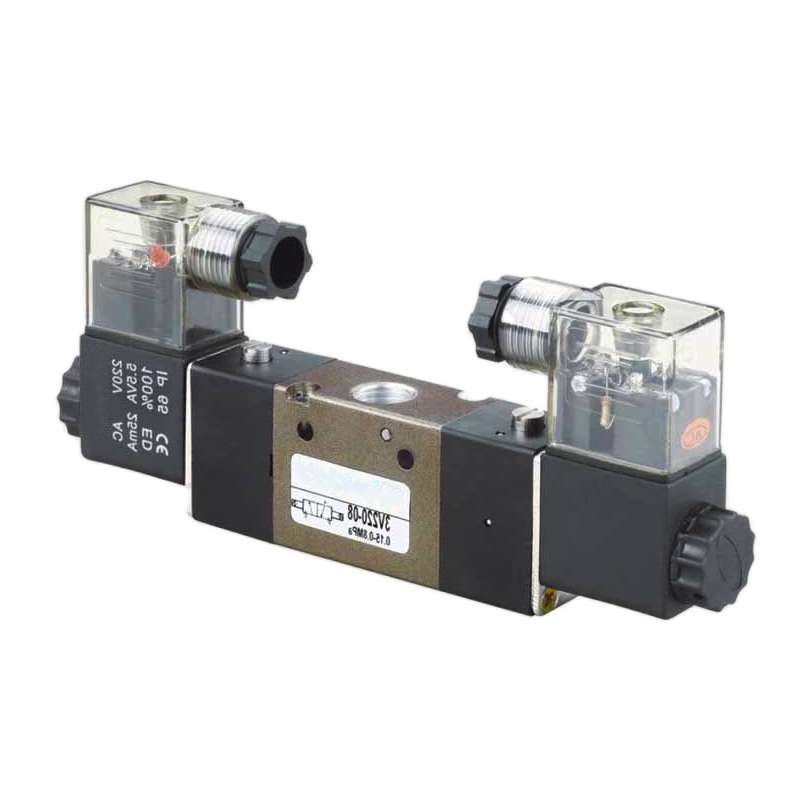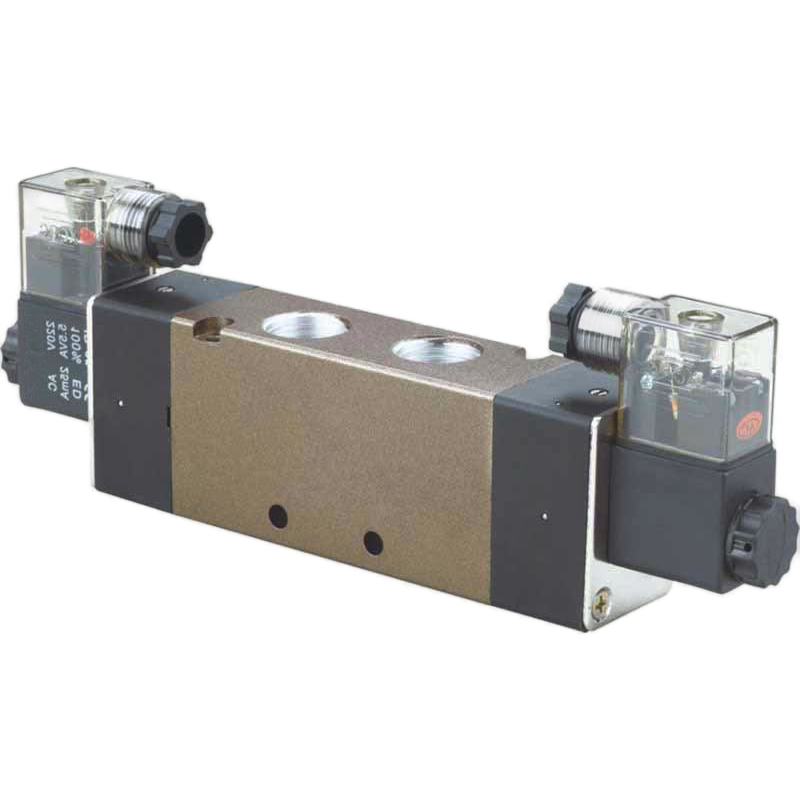When your pneumatic system suddenly loses position control or wastes trykluft1, the culprit is often an incorrectly specified 3-position valve center condition. Many engineers struggle with this critical decision, leading to inefficient systems and costly operational issues. The wrong choice can result in energy waste, poor positioning accuracy, and unexpected cylinder drift. 💸
Ventilcentrets 3-positioner bestemmer, hvordan portene opfører sig, når ventilen er i neutral position: Lukket center blokerer alt flow, udstødningscenteret ventilerer cylindrene til atmosfæren, og trykcenteret opretholder systemtrykket til alle porte for øjeblikkelig respons.
Just last month, I worked with Robert, a maintenance engineer at an automotive assembly plant in Detroit, who was experiencing inconsistent positioning in his rodless cylinder applications. His production line was losing thousands of dollars daily due to positioning errors caused by improper center condition selection.
Indholdsfortegnelse
- What Are the Different Types of 3-Position Valve Center Conditions?
- How Does Closed Center Configuration Affect System Performance?
- When Should You Choose Exhaust Center for Pneumatic Applications?
- What Are the Benefits of Pressure Center Valve Configuration?
What Are the Different Types of 3-Position Valve Center Conditions?
Understanding the three fundamental center conditions is crucial for optimal pneumatic system design. Each configuration serves specific operational requirements and affects system behavior differently.
The three main center conditions are closed center (all ports blocked), exhaust center (cylinder ports vented to atmosphere), and pressure center (supply pressure connected to all ports), each offering distinct advantages for different applications.
Closed Center Configuration
In closed center position, all valve ports are completely blocked when the valve is in neutral. This configuration maintains cylinder position by trapping air in both chambers, preventing any movement until the valve is actuated.
Exhaust Center Configuration
Exhaust center connects both cylinder ports to the exhaust while blocking the supply port. This allows the cylinder to move freely under external forces while venting any trapped air to atmosphere.
Pressure Center Configuration
Pressure center connects the supply port to all outlet ports simultaneously, maintaining full system pressure at the cylinder while blocking the exhaust port. This provides immediate response when the valve switches positions.
| Center Type | Supply Port | Cylinder Ports | Udstødningsport | Bedste anvendelse |
|---|---|---|---|---|
| Closed | Blocked | Blocked | Blocked | Holder positionen |
| Udstødning | Blocked | Connected to exhaust | Open | Manuel betjening |
| Tryk | Connected | Connected to supply | Blocked | Hurtig respons |
How Does Closed Center Configuration Affect System Performance?
Closed center valves offer the most energy-efficient solution for applications requiring precise position holding. This configuration prevents air consumption when the system is at rest.
Closed center configuration provides excellent position holding capability and maximum energy efficiency by completely blocking all ports, making it ideal for applications where cylinders must maintain position under load without consuming compressed air.
Fordele ved energieffektivitet
With all ports blocked in neutral position, closed center valves eliminate air consumption during idle periods. This can result in significant energy savings, especially in systems with long dwell times2.
Position Holding Characteristics
The trapped air in cylinder chambers acts as a pneumatic lock3, maintaining position even under external loads. However, this can cause pressure buildup if temperature changes occur.
Application Considerations
Robert’s Detroit facility initially used exhaust center valves, causing their rodless cylinders to drift under load. After switching to our Bepto closed center valves, they achieved precise position holding while reducing compressed air consumption by 40%. 🔧
When Should You Choose Exhaust Center for Pneumatic Applications?
Exhaust center configuration excels in applications requiring manual operation or where cylinders need to move freely when the valve is not actuated.
Exhaust center valves are ideal for emergency stop4 situations, manual override operations, and applications where cylinders must move freely under external forces without building up back pressure.
Safety Applications
In emergency situations, exhaust center valves automatically vent cylinder pressure, allowing operators to manually move equipment to safe positions without fighting against trapped air pressure.
Manual Override Capability
When maintenance requires manual cylinder movement, exhaust center configuration eliminates resistance from trapped air, making manual operation much easier and safer.
Overvejelser om systemet
| Funktion | Lukket center | Udstødningscenter |
|---|---|---|
| Position Holding | Fremragende | Dårlig |
| Manual Operation | Vanskeligt | Let |
| Energiforbrug | Lav | Medium |
| Emergency Safety | Begrænset | Fremragende |
What Are the Benefits of Pressure Center Valve Configuration?
Pressure center valves deliver the fastest response times by maintaining full system pressure at all cylinder ports, eliminating the time needed to build pressure during switching.
Pressure center configuration provides the fastest cylinder response times and highest force output by maintaining full supply pressure at all ports, making it perfect for high-speed applications requiring immediate acceleration.
Response Time Advantages
With pressure already present at cylinder ports, switching time is minimized since no pressure buildup is required. This can improve cycle times by 20-30% in high-speed applications.
Force Output Benefits
Full supply pressure availability ensures maximum force output immediately upon valve switching, crucial for applications requiring high breakaway forces or rapid acceleration.
Energy Considerations
While pressure center valves consume more energy due to continuous pressure supply, the improved productivity often justifies the higher operating costs in demanding applications.
Maria, who runs a packaging machinery company in Hamburg, switched to pressure center valves for her high-speed rodless cylinder applications. The improved response time increased her line speed by 25%, more than offsetting the additional energy costs. 📈
At Bepto, we offer all three center conditions with our replacement valve solutions, providing seamless compatibility with major OEM brands while delivering superior performance and cost savings.
Konklusion
Selecting the correct 3-position valve center condition is crucial for optimizing pneumatic system performance, energy efficiency, and operational safety in your specific application.
FAQs About 3-Position Valve Center Conditions
Q: Can I convert between different center conditions on existing valves?
Most 3-position valves cannot be converted between center conditions as this requires different internal spool configurations. You’ll need to replace the valve with the correct center condition type.
Q: Which center condition is best for rodless cylinder applications?
Closed center is typically preferred for rodless cylinders requiring position holding, while pressure center works best for high-speed applications. The choice depends on your specific performance requirements.
Q: Do different center conditions affect valve lifespan?
Pressure center valves may experience slightly more wear due to continuous pressure exposure, but quality valves like our Bepto replacements are designed to handle all center conditions reliably.
Q: How do I identify the center condition of my current valve?
Check the valve’s schematic symbol or part number specifications. Our technical team can help identify your current configuration and recommend the optimal replacement solution.
Q: What happens if I use the wrong center condition?
Wrong center conditions can cause position drift, energy waste, poor response times, or safety issues. Proper selection is critical for optimal system performance and operational safety.
-
Learn about the properties and common industrial uses of compressed air as an energy source. ↩
-
Understand the concept of “dwell time” in manufacturing and how it refers to a programmed pause in a machine’s cycle. ↩
-
Explore the principle of a pneumatic lock, where trapped, pressurized air is used to hold an actuator in a fixed position. ↩
-
Read about the safety principles and requirements for emergency stop (e-stop) functions, often governed by standards like ISO 13850. ↩





